NEOLITHIC FARMERS
Failing to detect significant African or Middle Eastern ancestry in Southern Europe, hardcore Nordicists have been forced to use the higher frequency of Neolithic Levantine ancestry in the South as evidence of "non-white" admixture. However, they forget that this ancestry dates back to pre-historic times (c. 10,000 B.P.); that research differentiates it from that of modern Arab-influenced Near Easterners; and that all Europeans are part Neolithic, perhaps to a greater extent than previously thought.
Anthropology"There are two variants of the Classic Mediterranean type—straight-nosed and hook-nosed. The former is the more primitive and the more widely distributed. It extended in prehistoric times along both shores of the Mediterranean, into central, western, and northern Europe and down into the Horn of Africa. Its area of characterization and source of dissemination cannot have been far from the traditional Garden of Eden—Mesopotamia, which archaeologists include in 'the Fertile Crescent.'
"The expansion of the aquiline or hook-nosed Mediterranean type seems to have been somewhat more limited and probably later than that of the straight-nosed variant. In historical times, it was carried into North Africa and Spain principally by the Arabs, but other Semitic-speaking and non-Semitic peoples of prehistoric times may well have possessed this variation. Some of this type may have reached India, but nasal convexity there seems largely the result of infusions of the Iranian Plateau type."
* * *"Although the first agricultural inhabitants of the belt from Syria-Israel-Jordan to North Africa were mainly rugged Mediterranean (A3 and some B, in varying preponderance) the eastern end of this belt (McGown, 1939; Vallois, 1936), shows some almost Bushmen-like Basic White (A4b) as well as lateral traits (E1 and C4 [Mixed Alpine and Alpine]) as at Jericho."
[NOTE: Type B is labeled "Classic Mediterranean"; the diverse Basic White Type A is compared to British Atlanto-Mediterraneans and Cro-Magnons; and the Mixed Alpine Type E1 is part Basic White.]
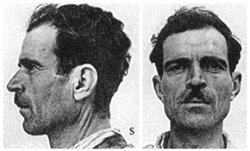 Type B (Mediterranean) |
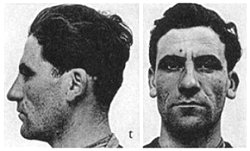 Type B (Mediterranean) |
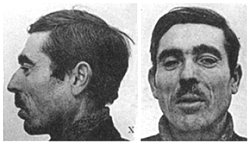 Type A3 (Basic White) |
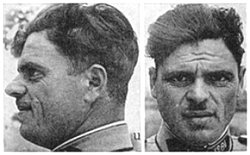 Type A4 (Basic White) |
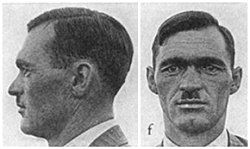 Type E1 (Mixed Alpine) |
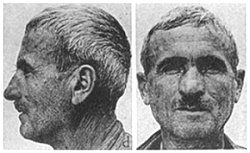 Type C4 (Alpine) |
Genetics
"The significant genetic structuring of populations facing the Mediterranean basin into three groupings, Near Eastern Arab, Mediterranean and North African, is related to the demographic processes that have occurred since first populating the area. The distribution of Neolithic technologies was probably paralleled by demographic expansion in the Mediterranean basin, and subsequent westward migration by Phoenicians and Greeks contributed to the distribution of Y chromosome types of most likely Near East origin. The Arab conquest in particular appears to have had a dramatic influence on the East and South Mediterranean coasts, with differential sex-related gene flow playing a major role in the distribution of genetic variation. The presence of Arab Y chromosome lineages in the Middle East suggests that most have experienced substantial gene flow from the Arabian peninsula. This result raises the issue of the correctness of identifying all Near Eastern populations as reliable representations of the original Neolithic groups that expanded from the Middle East towards the European peninsula."
* * *
The lineages associated with migrations of Neolithic agriculturalists are HG9 (J) and HG21 (E3b) on the Y-chromosome, and mtDNA haplogroups J, T1, U3 and certain H and W subclusters. Note the uneven distribution of these below, with the paternal Y ancestry differing greatly between SE and SW Europeans despite close racial ties, and maternal ancestry being higher in N and C Europeans than in S Europeans.
HG9/21 Frequencies for Europe, Central Asia and the Mediterranean:
| Algerians.....93%
(41/52) N Africans....89% (12/77) Cypriots......60% (33/27) Greeks........56% (28/28) Turks.........43% (33/10) Ossetians.....40% (34/ 6) Armenians.....32% (29/ 3) Italians......32% (18/14) Romanians.....31% (24/ 7) Bulgarians....29% (12/17) Georgians.....25% (23/ 2) Yugoslavs.....21% ( 8/13) Hungarians....20% ( 3/17) Czechs........19% (11/ 8) Portuguese....19% ( 7/12) Dutchmen......15% ( 7/ 8) Frenchmen.....13% ( 5/ 8) Slovakians....13% ( 3/10) Spaniards.....13% ( 3/10) Slovenians....13% ( 6/ 7) Chuvash.......12% ( 6/ 6) |
Belarusians...12%
( 2/10) Russians......11% ( 4/ 7) Germans.......10% ( 5/ 5) Danes..........9% ( 7/ 2) Poles..........6% ( 4/ 2) Maris..........6% ( 6/ 0) Ukrainians.....4% ( 0/ 4) East Anglians..4% ( 1/ 3) Belgians.......4% ( 5/ 2) Swedes.........4% ( 2/ 2) Norwegians.....4% ( 2/ 2) Estonians......4% ( 1/ 3) Irishmen.......3% ( 1/ 2) Finns..........2% ( 0/ 2) Scotsmen.......1% ( 1/ 0) Cornishmen.....0% ( 0/ 0) Latvians.......0% ( 0/ 0) Lithuanians....0% ( 0/ 0) Icelanders.....0% ( 0/ 0) Lapps..........0% ( 0/ 0) Basques........0% ( 0/ 0) |
Neolithic mtDNA Frequencies (Europe only):
| North-West.........22% | (Irish, English, Welsh, Cornish and French) | |
| South-East.........20% | (Bulgarians and Romanians) | |
| North-East.........18% | (Finns, Karelians, Estonians, Chuvash and Russians) | |
| North-Central......17% | (Germans, Czechs, Danes and Poles) | |
| Alps...............15% | (Austrians, Swiss and Bavarians) | |
| Scandinavia........12% | (Norwegians, Icelanders and Swedes) | |
| Western Med........12% | (Galicians, Spaniards and Portuguese) | |
| Eastern Med........11% | (Greeks and Albanians) | |
| Central Med.........9% | (Sardinians, Sicilians, Tuscans and Romans) | |
| Basque Country......7% | (Spanish Basques) |
"We analyzed a large dataset of 22 binary markers from the non-recombining region of the Y chromosome.... The results reveal a significantly larger genetic contribution from Neolithic farmers than did previous indirect approaches based on the distribution of haplotypes selected by using post hoc criteria.... We also argue that local hunter-gatherers contributed less than 30% in the original settlements. This finding leads us to reject a predominantly cultural transmission of agriculture.
"We found an average Neolithic contribution of 50% across all samples, 56% for the Mediterranean subset and 44% in non-Mediterranean samples. Thus, whichever region of Europe is considered, we find that the average value is more than twice that suggested by [previous studies] on the basis of the more readily apparent trends.
Albanians...........74%
Greeks..............71%
Macedonians.........69%
Georgians...........64%
Calabrians..........61%
Hungarians..........60%
Croatians...........56%
Poles...............52%
North Italians......46%
Ukrainians..........44%
Dutchmen............41%
Germans.............40%
Catalans............39%
Frenchmen...........38%
Czechs/Slovaks......38%
Andalusians.........31%
Sardinians..........15%
"Our assessment of the demographic impact of the Neolithic expansion into Europe is largely independent from, but appears consistent with, archaeological evidence, simulations, and classical studies of allele frequencies. Despite some reports of its demise, the original [demic diffusion] model proposed by Ammerman and Cavalli-Sforza is more alive than ever."
(Chikhi et al. 2002)
* * *
(Chikhi et al. 1998)"Comparisons between archaeological findings and allele frequencies at protein loci suggest that most genes of current Europeans descend from populations that have been expanding in Europe in the last 10,000 years, in the Neolithic period. Recent mitochondrial data have been interpreted as indicating a much older, Paleolithic ancestry. In a spatial autocorrelation study at seven hypervariable loci in Europe (four microsatellites, two larger, tandem-repeat loci, and a sequence polymorphism) broad clinal patterns of DNA variation were recognized. The observed clines closely match those described at the protein level, in agreement with a possible Near Eastern origin for the ancestral population. Separation times between populations were estimated on the basis of a stepwise mutation model. Even assuming low mutation rates and long generation times, we found no evidence for population splits older than 10,000 years, with the predictable exception of Saami (Lapps). The simplest interpretation of these results is that the current nuclear gene pool largely reflects the westward and northward expansion of a Neolithic group. This conclusion is now supported by purely genetic evidence on the levels and patterns of microsatellite diversity, rather than by correlations of biological and nonbiological data. We argue that many mitochondrial lineages whose origin has been traced back to the Paleolithic period probably reached Europe at a later time."
Related Topics
European Genetic Variation: Neolithic ancestry comprises the 1st component of variation.
Neolithic Racial Types: Lengthier descriptions from Angel. (Also more photographic plates.)
IJ-S22: "Missing link" between Northern European haplogroup I and Middle Eastern haplogroup J (HG9).
